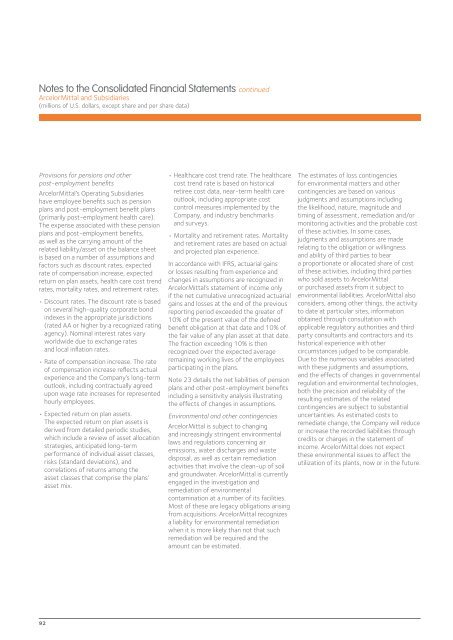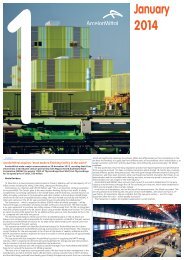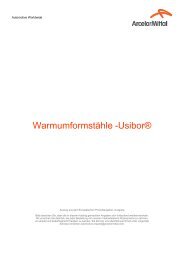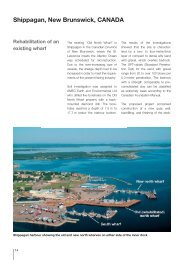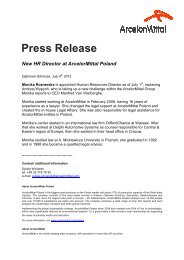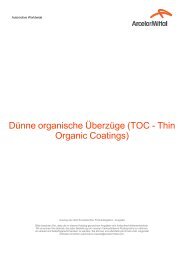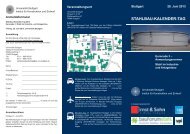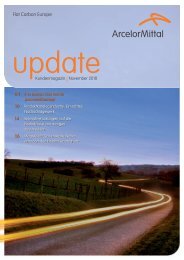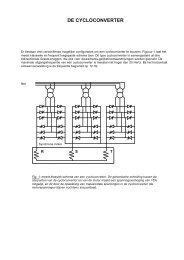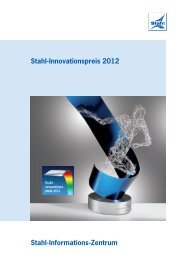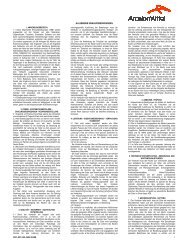ArcelorMittal Annual Report 2008
ArcelorMittal Annual Report 2008
ArcelorMittal Annual Report 2008
Create successful ePaper yourself
Turn your PDF publications into a flip-book with our unique Google optimized e-Paper software.
Notes to the Consolidated Financial Statements continued<br />
<strong>ArcelorMittal</strong> and Subsidiaries<br />
(millions of U.S. dollars, except share and per share data)<br />
Provisions for pensions and other<br />
post-employment benefits<br />
<strong>ArcelorMittal</strong>’s Operating Subsidiaries<br />
have employee benefits such as pension<br />
plans and post-employment benefit plans<br />
(primarily post-employment health care).<br />
The expense associated with these pension<br />
plans and post-employment benefits,<br />
as well as the carrying amount of the<br />
related liability/asset on the balance sheet<br />
is based on a number of assumptions and<br />
factors such as discount rates, expected<br />
rate of compensation increase, expected<br />
return on plan assets, health care cost trend<br />
rates, mortality rates, and retirement rates.<br />
• Discount rates. The discount rate is based<br />
on several high-quality corporate bond<br />
indexes in the appropriate jurisdictions<br />
(rated AA or higher by a recognized rating<br />
agency). Nominal interest rates vary<br />
worldwide due to exchange rates<br />
and local inflation rates.<br />
• Rate of compensation increase. The rate<br />
of compensation increase reflects actual<br />
experience and the Company’s long-term<br />
outlook, including contractually agreed<br />
upon wage rate increases for represented<br />
hourly employees.<br />
• Expected return on plan assets.<br />
The expected return on plan assets is<br />
derived from detailed periodic studies,<br />
which include a review of asset allocation<br />
strategies, anticipated long-term<br />
performance of individual asset classes,<br />
risks (standard deviations), and<br />
correlations of returns among the<br />
asset classes that comprise the plans’<br />
asset mix.<br />
92<br />
• Healthcare cost trend rate. The healthcare<br />
cost trend rate is based on historical<br />
retiree cost data, near-term health care<br />
outlook, including appropriate cost<br />
control measures implemented by the<br />
Company, and industry benchmarks<br />
and surveys.<br />
• Mortality and retirement rates. Mortality<br />
and retirement rates are based on actual<br />
and projected plan experience.<br />
In accordance with IFRS, actuarial gains<br />
or losses resulting from experience and<br />
changes in assumptions are recognized in<br />
<strong>ArcelorMittal</strong>’s statement of income only<br />
if the net cumulative unrecognized actuarial<br />
gains and losses at the end of the previous<br />
reporting period exceeded the greater of<br />
10% of the present value of the defined<br />
benefit obligation at that date and 10% of<br />
the fair value of any plan asset at that date.<br />
The fraction exceeding 10% is then<br />
recognized over the expected average<br />
remaining working lives of the employees<br />
participating in the plans.<br />
Note 23 details the net liabilities of pension<br />
plans and other post-employment benefits<br />
including a sensitivity analysis illustrating<br />
the effects of changes in assumptions.<br />
Environmental and other contingencies<br />
<strong>ArcelorMittal</strong> is subject to changing<br />
and increasingly stringent environmental<br />
laws and regulations concerning air<br />
emissions, water discharges and waste<br />
disposal, as well as certain remediation<br />
activities that involve the clean-up of soil<br />
and groundwater. <strong>ArcelorMittal</strong> is currently<br />
engaged in the investigation and<br />
remediation of environmental<br />
contamination at a number of its facilities.<br />
Most of these are legacy obligations arising<br />
from acquisitions. <strong>ArcelorMittal</strong> recognizes<br />
a liability for environmental remediation<br />
when it is more likely than not that such<br />
remediation will be required and the<br />
amount can be estimated.<br />
The estimates of loss contingencies<br />
for environmental matters and other<br />
contingencies are based on various<br />
judgments and assumptions including<br />
the likelihood, nature, magnitude and<br />
timing of assessment, remediation and/or<br />
monitoring activities and the probable cost<br />
of these activities. In some cases,<br />
judgments and assumptions are made<br />
relating to the obligation or willingness<br />
and ability of third parties to bear<br />
a proportionate or allocated share of cost<br />
of these activities, including third parties<br />
who sold assets to <strong>ArcelorMittal</strong><br />
or purchased assets from it subject to<br />
environmental liabilities. <strong>ArcelorMittal</strong> also<br />
considers, among other things, the activity<br />
to date at particular sites, information<br />
obtained through consultation with<br />
applicable regulatory authorities and third<br />
party consultants and contractors and its<br />
historical experience with other<br />
circumstances judged to be comparable.<br />
Due to the numerous variables associated<br />
with these judgments and assumptions,<br />
and the effects of changes in governmental<br />
regulation and environmental technologies,<br />
both the precision and reliability of the<br />
resulting estimates of the related<br />
contingencies are subject to substantial<br />
uncertainties. As estimated costs to<br />
remediate change, the Company will reduce<br />
or increase the recorded liabilities through<br />
credits or charges in the statement of<br />
income. <strong>ArcelorMittal</strong> does not expect<br />
these environmental issues to affect the<br />
utilization of its plants, now or in the future.


